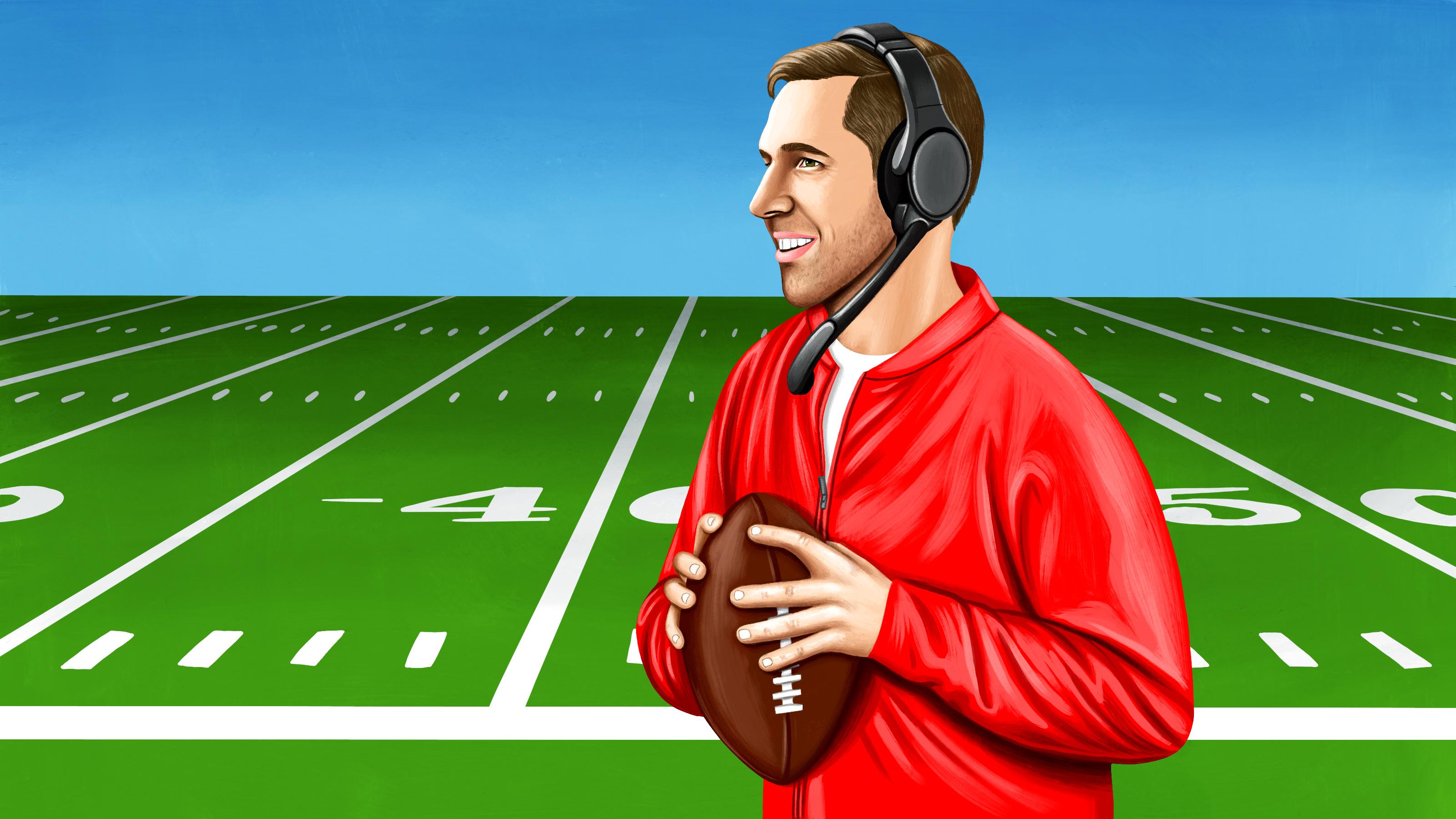Kyle Shanahan Is Always One Step Ahead
Over the past five years, the 49ers’ coach has become the best offensive mind in football. And his constant reinvention is what has San Francisco playing for its first Super Bowl in a quarter century.Kyle Shanahan can see the future. That may sound like a stretch, but it’s true. A few days after the Niners’ blowout win in the NFC championship game, a sideline clip of their head coach began making the internet rounds. In it, Shanahan approached an official during San Francisco’s game-sealing drive in the fourth quarter and described what was about to happen on the following play. He explained that tight end George Kittle would make a quick break inside before bending back toward the sideline. “He won’t let him out,” Shanahan said of the Green Bay defender covering Kittle. “Watch.”
The play unfolded precisely the way Shanahan envisioned: Kittle was held, a flag was thrown, and the Niners were gifted a first down that helped send them to the Super Bowl. That flash of psychic powers may seem like a throwaway moment at the tail end of a convincing win, but it speaks to what sets Shanahan apart as a play-caller: He always understands exactly how to manipulate a defense’s expectations. “That’s going to happen ’cause it messes with the [cornerback]’s rules,” says former Browns receiver Andrew Hawkins. “That’s what he teaches, and he knows exactly how DBs have been taught to play when a receiver releases inside.”
Hawkins was 28 when he played for Shanahan during the coach’s lone season as Cleveland’s offensive coordinator in 2014. A professed receiver nerd, Hawkins had spent his entire life studying and honing techniques that he viewed as gospel. Over a single offseason, Shanahan and receivers coach Mike McDaniel recalibrated everything Hawkins thought he knew about getting open. “It took some trust there, ’cause I’m like, ‘Well, this has worked for me forever,’” Hawkins says. “But in doing whatever we’re doing, their goal is always to make the game easier. It’s not to just pound in ‘This is our philosophy, this is how we do it.’ They basically promise you, ‘If you follow these rules, the game will be easier.’’’
In the five years since his stint in Cleveland, Shanahan has emerged as the premier offensive mind in football. As the offensive coordinator in Atlanta, he helped Matt Ryan win an MVP award in 2016 and took the Falcons to the doorstep of a championship. His multidimensional approach in San Francisco has turned the Niners into a buzzsaw that’s run teams into the ground this postseason. And now, for the first time since the Falcons’ crushing loss to the Patriots three years ago, Shanahan has a team back in the Super Bowl. No play-caller in the NFL has a better grasp of how to bend—and sometimes break—the parameters of football to stay one step ahead, and that prophetic mind has taken the 49ers to the precipice of their first championship in a quarter century.
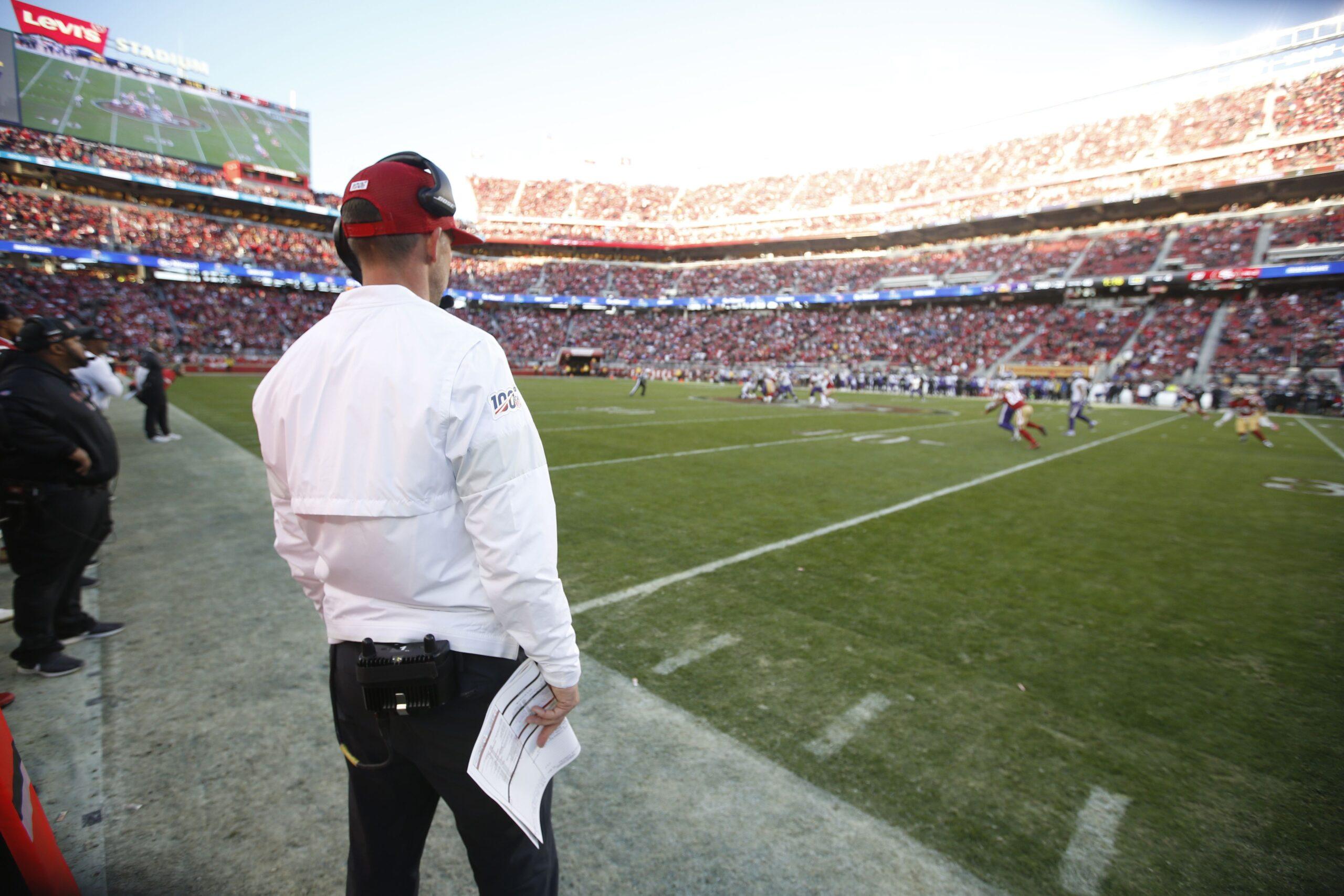
Mike McDaniel doesn’t look like a football coach—and he knows it. Wearing black Tom Ford glasses, a cream-colored John Elliott hoodie, and a pair of Yeezys, the Niners’ 36-year-old run-game coordinator seems like he should be playing Cones of Dunshire at Gryzzl, not devising the most complicated rushing attack in the NFL. Like Shanahan, McDaniel never played pro football. He’s a Yale grad who was hired by Shanahan’s father, Mike, as a Broncos intern in 2005, and he’s followed Kyle to every subsequent stop of their coaching careers. That unusual résumé might have been a hindrance for some, but McDaniel says Shanahan taught him early on that his lack of football pedigree could actually serve a purpose. “One of the positive consequences of not playing professional football is that [Shanahan] was constantly aware that he had to add value to a player,” McDaniel says. “He’s instilled all the coaches that have followed him with that same vigor. I need to add value to a professional athlete. I haven’t played. I have to think outside the box.”
Similarly, Shanahan’s own insecurities have fueled his mind-set as a play-caller. To prove his worth, he needs a solution to every possible query that might arise Sunday. “The fear of all of a sudden not having an answer for his players during a game,” McDaniel says, “that causes you to kind of problem solve and forecast what defenses could possibly do. And make sure you have an answer for that.”
Even as the head coach, Shanahan still leads the Niners’ installation meetings each week. He’s at the front of the room each Wednesday morning, walking the offense through their first- and second-down packages for the coming game. Shanahan is a brilliant designer, but he’s equally gifted at communicating the thinking behind his plays. “Whereas some coaches might have an idea, an inkling of how they want to get it done, being able to explain it in a way a player understands and is able to execute his assignment is a whole other ballgame,” says Falcons backup quarterback Matt Schaub, who’s spent four total seasons with Shanahan during stops in Atlanta and Houston.
The way that McDaniel and others describe it, Shanahan presents ideas through stories. He starts at the most basic level, by articulating what defenses are built to stop and why. From there, he walks players through the motivation behind each element of the play. McDaniel says the system is “part to whole”—each individual piece serves a purpose within the larger picture. And Shanahan wants each player to understand how the entire mechanism functions. Every member of the offense is encouraged to study each component of a given route combination, because it’s only a matter of time before Shanahan devises a way to swap the pieces and make the same play look like something entirely different. “When you put it in, you tell guys, ‘Don’t just learn what you have,’” says tight ends coach Jon Embree. “You better learn the whole concept. Because at some point, Kyle’s going to be put you into one of these spots.”
Shanahan is a master of understanding how each element of a given concept will impact a defense, but he also has a preternatural sense for how those designs fit into the larger picture of a game. There have been times this season when McDaniel and offensive line coach John Benton have expressed skepticism about the viability of a certain run concept, and Shanahan has convinced them that sometimes, a 3-yard gain is worth it—if that gain sets up a 70-yard touchdown two quarters later. “What truly makes him great and separates him from other coaches is the way he categorizes stuff when he’s getting ready to call the game,” McDaniel says. “His preparation to call a game enables him to do that. He goes through every scenario. If A works, then we go to B. But if A doesn’t work, then we go to C. It’s something that he’s done an absolutely masterful job at since he became a coordinator.”
His obsession with finding those patterns means that Shanahan’s mind rarely turns off. For most teams, the offensive game plan locks after the final team meeting on Saturday night, which allows players to digest the menu and spend the next 12 hours visualizing what they’ve studied all week. But when Shanahan was in Atlanta, he’d often burst into the locker room on Sunday morning with some last-minute thoughts. “As far as the adjustments just on the fly in street clothes and everything on a Sunday morning, Matt Ryan wasn’t necessarily cool with that,” says Schaub. “Kyle sometimes would come to me, because we had a longstanding prior relationship, and be like, ‘Hey, what do you think about this? Do you think he’d be for it?’ And I’d be like, ‘You know what? Let’s just hold on it until midway through the first quarter.’”
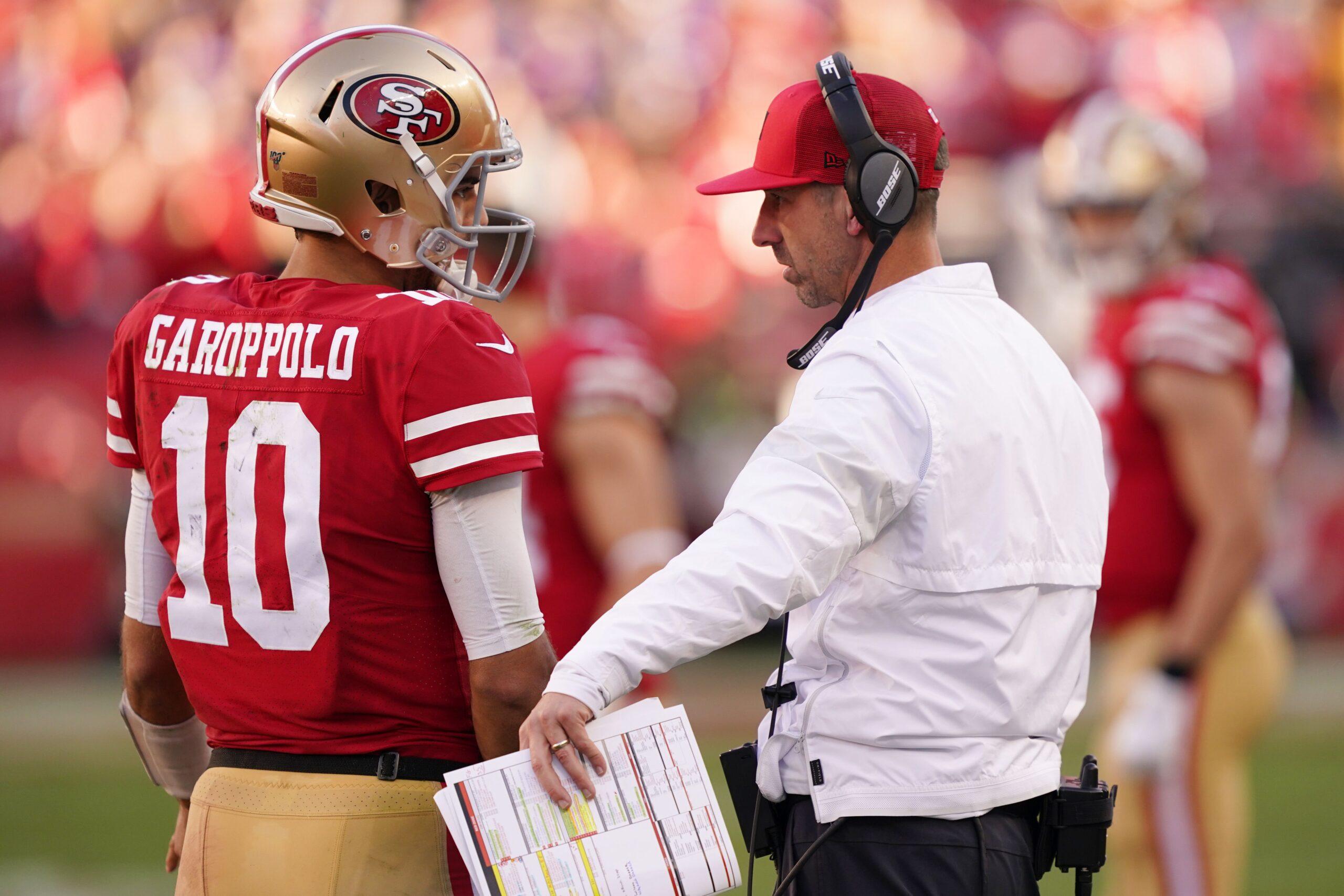
Seven years passed between Schaub’s last season under Shanahan in Houston and his first in Atlanta. Shanahan called the Texans’ plays during his final two seasons in Houston, but Gary Kubiak still had a heavy influence on the particulars of the offense. When Schaub arrived in Atlanta, the bones of the system resembled the play-action-heavy system that Kubiak and Mike Shanahan had run for years, but Shanahan had conceived a variety of new drop-back passing concepts aimed at exploiting modern coverages. “Defense has evolved over the last 10 years of football—some coverages and how teams are playing coverages and certain formations,” Schaub says. “So when they’re constantly changing to stop what the themes are of offenses and the passing games, so too was [Shanahan’s] offense.”
Shanahan still espouses the baseline Kubiak system that he’s used for more than a decade, but his genius lies in the alterations he’s made—and continues to make—to that scheme. Hawkins estimates that about 60 to 65 percent of Shanahan’s core playbook travels with him from stop to stop and season to season. The other 35 percent is reserved for ideas specifically tailored to his offensive personnel and the defensive concepts used against him.
In Cleveland, those updates meant including more routes that took advantage of the speed and quickness of the Browns’ receivers. With fast but small burners like Hawkins and Taylor Gabriel on the outside, Shanahan installed a series of mirrored stop routes designed to threaten defenses vertically before gashing them for 18-yard completions underneath. In Atlanta, the staff was compelled to constantly find new ways to maximize Julio Jones. And in San Francisco, Shanahan has cooked up creative ways to get Deebo Samuel and Raheem Mostert the ball in space. “Sometimes you have backs with ball skills,” McDaniel says. “Sometimes you have receiving tight ends. Sometimes the strength of your offensive line is your tackles. It’s just constant problem-solving.”
This season, Shanahan has made arguably his most significant departure from his core football principles by changing up his rushing attack. Since his Houston days, Shanahan’s ground game has consisted of primarily zone-running designs. But this year, the Niners tapped into gap and power schemes unlike ever before. Heading into their game against the Steelers in Week 3, Shanahan knew that Pittsburgh played its outside linebackers so wide that beating them to the edge would be virtually impossible. So rather than running the ball to the perimeter, the Niners deployed gap-scheme runs that exploited the extra space between the tackles. San Francisco racked up 165 yards on 34 running back carries as Shanahan called more counter run plays in one game than he had in his previous 10 seasons combined.
Play-action throws are typically considered the counterpunches within Shanahan’s offense, but gap runs serve the same purpose. They’re uniquely suited to take advantage of defenses that are preoccupied with stopping outside zone. The Niners took that deception a step further this year by also using jet motion—a common wrinkle on their zone runs—on gap runs for the first time. “That really opened a door to things,” Benton says. “We probably got a little enamored with it, to be honest.”
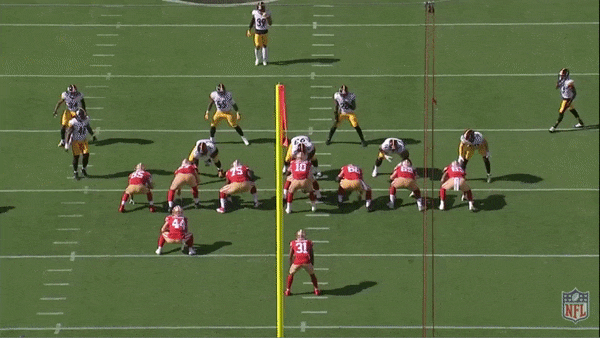
Pairing the jet action with gap runs was just the latest step that Shanahan and his staff took to push this offense forward—and to ensure that defenses stayed a step behind. “You pick up tools each and every year, as long as you’re still pushing the envelope and making sure that you’re not getting lethargic,” McDaniel says. “So because of that, you end up saying, ‘OK, when they take this away, this has an advantage.’”
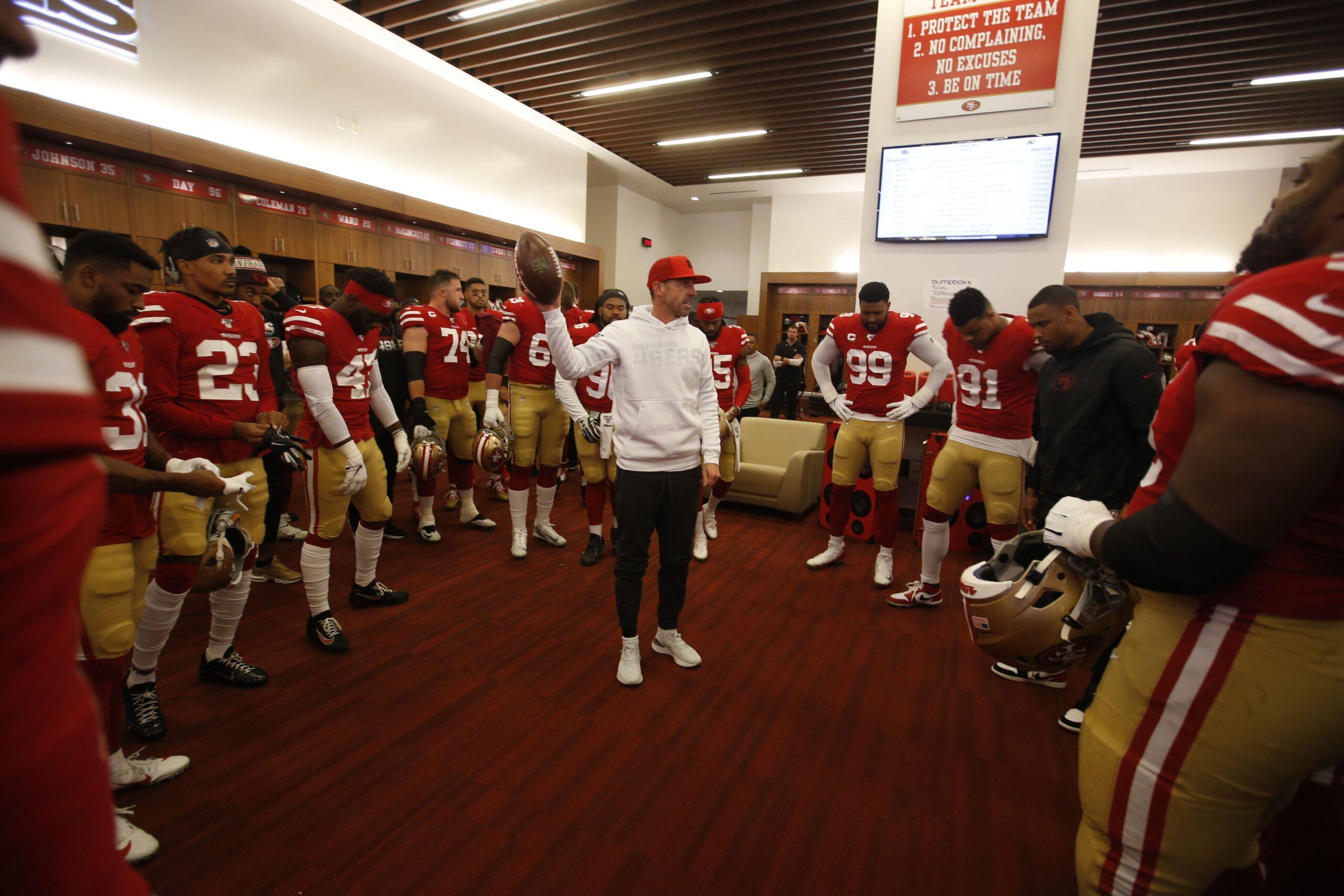
One of the Niners’ favorite passing designs is a concept called “Burner.” The play includes a route combination that’s become a staple for coaches on the Shanahan tree, including Sean McVay and Matt LaFleur: a wide-zone play-action design that includes a high corner route by the no. 1 (farthest outside) receiver and a deep over route by the backside receiver coming across the formation. Traditionally, it’s run with a pair of wide receivers and looks something like this:
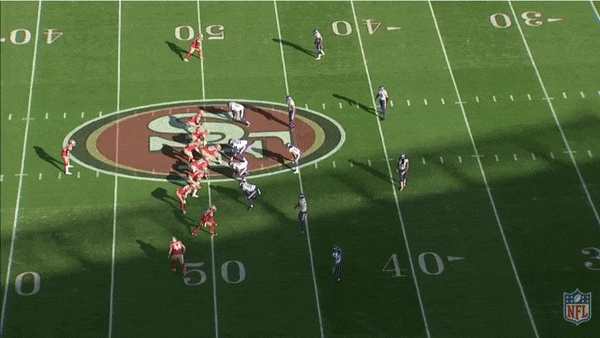
At its most basic level, the goal of the Shanahan system is to seamlessly marry runs and play-action passes. The thinking is that if every play looks the same for the first few steps, defenses won’t be able to tell the difference until it’s too late. To that end, Burner serves as a complement to the Niners’ zone-running DNA. It’s Step 2 in the process. The difference between Shanahan and most other play-callers, though, is that by the time defenses have accounted for his second move, he’s already planning his third.
Against the Packers in Week 12, the Niners came out in a three-tight-end set on a first-and-10 from their own 39-yard line. At the snap, they go right into their Burner concept, except this time, Kittle is the no. 1 receiver to the play side. The formation and personnel might be different, but for the first 15 yards, every detail of the routes resembles the Niners’ standard Burner combination. But then, just as cornerback Kevin King turns his hips, Kittle cuts back to the inside and breaks wide open for a 61-yard touchdown. Every aspect of the play mimics a design that defenses have been trained to recognize and react to, and by using a different personnel grouping and a slight adjustment, Shanahan twists that preparation to serve his own ends.
As they try to predict what offenses are going to do on a given play, defenses can only rely on indicators. And by fully comprehending how the information he presents will manipulate his opponent, Shanahan is able to use a defense’s own rules to his advantage. “There’s no completely gotcha-type play,” McDaniel says. “In cohesion with other plays, when you can stress them differently and get them moving, the only way a defense can truly take something away is that they leave themselves vulnerable to something else.”
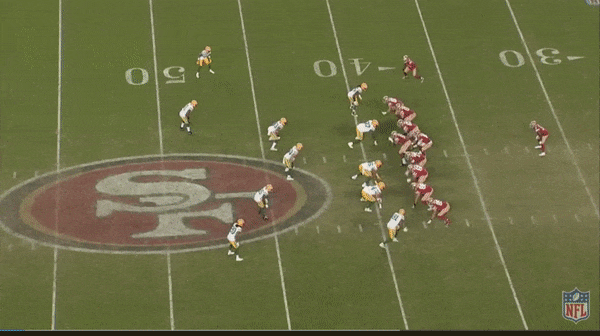
If the Burner post was the only variation defenses had to account for against the Niners, they might have a fighting chance. But San Francisco has about a dozen other counters to go along with it. That includes the leak concept that Shanahan has made famous—the one that resulted in a 38-yard touchdown to Marquise Goodwin in Week 2.
All NFL play-callers have variants like this within their offenses. What differentiates Shanahan is his uncanny sense for how and when to unleash them. McDaniel says that he’s never seen his boss watch a game without his play-calling antennae up. That restless mind—and Shanahan’s insatiable thirst to find the right answer in every situation—has made him into the best play-caller alive. And it gives the Niners a real chance at exorcising their coach’s Super Bowl demons on Sunday. “It’s not just the drawing and the schematics,” McDaniel says. “It’s really the feeling of the game. When you’re thinking that way over three or four decades, all of a sudden, you just feel when a defense has been stressed. … There’s no shortcut. There’s no path of least resistance. It’s something that’s he chipped away at for the last two decades.”
